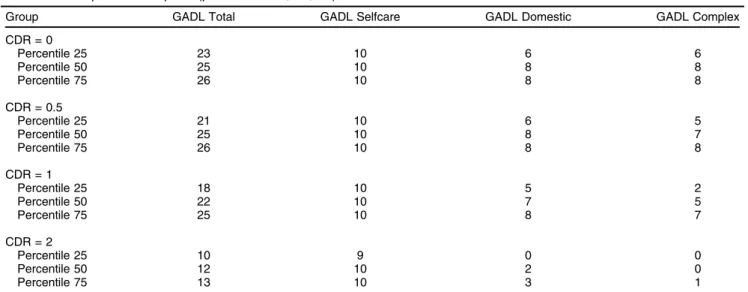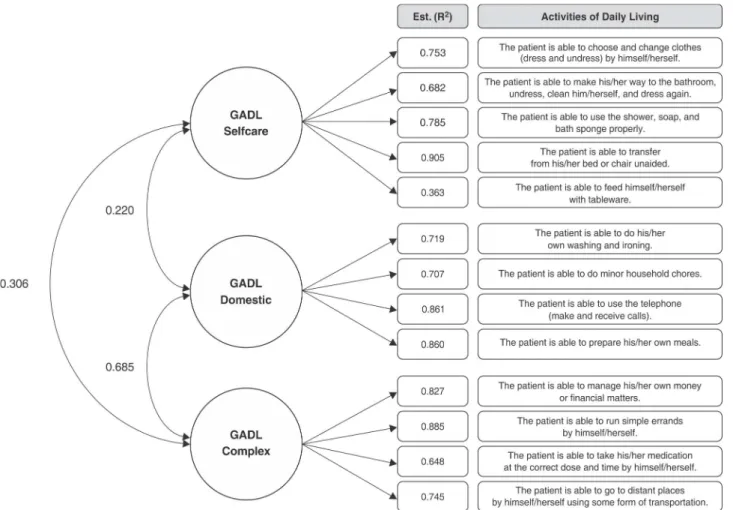LETTERS TO THE EDITORS
Confirmatory factor analysis
of the general activities of
daily living scale: further
evidences of internal validity
Rev. Bras. Psiquiatr. 2017;39:379–380doi:10.1590/1516-4446-2017-2256
The assessment of older adults with neurocognitive dis-orders involves the investigation of functional impairment. Usually, this is conducted by examining activities of daily living (ADL), everyday activities that should be performed without great difficulties by the patients.1The most
com-mon method for measuring ADL is the use of scales and questionnaires, since they are mainly brief, low cost, and accurate.2
In a previous issue ofRevista Brasileira de Psiquiatria, we presented the General Activities of Daily Living Scale (GADL),3an instrument to assess different aspects of ADL in older adults. The GADL emphasized activities commonly assessed in clinical/research settings in Brazil, showing evidence of validity and reliability. At the time, an explo-ratory factor analysis suggested a three-factor structure based on activity complexity (self-care, domestic, and complex activities) as the latent structure of ADL in our sample. The GADL three-factor structure also met evi-dence of external validity, with each GADL factor differen-tially associated with complex (i.e., cognitive functioning) and more simple (i.e., finger dexterity) tasks.4 However,
Confirmatory Factor Analysis (CFA) can provide further evidence for the suggested three-factor GADL model.
In this letter, we tested the GADL three-factor hypoth-esis in a larger and more heterogeneous sample of older adults (n=578: 369 women) using CFA. We used a con-joined dataset of three research projects, approved by the local ethics committees of two universities in Belo Horizonte, Brazil. Participants or their caregivers, in the case of demen-tia, gave written consent for participation. Mean participant age was relatively high (76.067.0 years) and mean educa-tion predominately low (4.3364.21 years). Participants had a diagnosis of minor (n=247) or major neurocognitive dis-order (n=228) irrespective of etiological stratification, other mental disorders coursing with cognitive-functional com-plaints (n=46), or were considered healthy controls (n=66). We stratified the sample based on clinical dementia rating5 (CDR) scores. Table 1 shows a brief description of the sample, according to CDR and GADL scores.
Confirmatory analysis was performed using MPlus 6.1 software. We used a diagonally weighted least squares method, which is commonly adopted to analyze ordinal data. Factors were defined as in the original study3:
Self-care (dressing/undressing, using the toilet, showering, transferring to toilet, feeding), Domestic (washing/ironing, household chores, using the telephone, preparing meals), and complex (financial control, shopping, controlling medication, using transportation). As expected in CFA,6
we used different fit indexes to test the model: the root mean square error of approximation (RMSEA, desired valueso0.06), the comparative fit index and the
Tucker-Leis index (CFI and TFI, desired values 4 0.95), and w2/degrees of freedom (w2/df, desired valueso3).
Standardized estimates (R2) and factor correlations are shown in Figure 1. Our results indicated an adequate model fit for the three-factor model: RMSEA = 0.059, CFI/TLI = 0.984/0.980, and w2/df = 2.83, showing convergence with
our previous research.3,4 Most factor loads were above 0.6, showing a strong relationship with each factor. The only
Table 1 Participants description (percentiles 25, 50, 75)
Group GADL Total GADL Selfcare GADL Domestic GADL Complex
CDR = 0
Percentile 25 23 10 6 6
Percentile 50 25 10 8 8
Percentile 75 26 10 8 8
CDR = 0.5
Percentile 25 21 10 6 5
Percentile 50 25 10 8 7
Percentile 75 26 10 8 8
CDR = 1
Percentile 25 18 10 5 2
Percentile 50 22 10 7 5
Percentile 75 25 10 8 7
CDR = 2
Percentile 25 10 9 0 0
Percentile 50 12 10 2 0
Percentile 75 13 10 3 1
CDR = Clinical Dementia Rating (0 = no dementia; 0.5 = questionable dementia; 1 = mild dementia; 2 = moderate dementia); GADL = General Activities of Daily Living Scale.
Revista Brasileira de Psiquiatria. 2017;39
item with a lower factor load was ‘‘The patient is able to feed himself/herself with tableware’’. This probably occurred due to the low variance of the measure, since our sample only included patients with moderate or milder dementia, and this activity is usually impaired in advanced stages of dementia.7
Therefore, GADL is a brief, easy to use, and well-validated measure of functional performance for the asses-sment of older adults as increasing evidence suggests. Future studies should attempt to replicate these results in other samples, thus heightening the reliability and consis-tency of GADL for clinical use.
Jonas Jardim de Paula,1,2Maicon Rodrigues Albuquerque,1 Maria Aparecida Camargos Bicalho,1
Marco Aure´lio Romano-Silva1
1Universidade Federal de Minas Gerais (UFMG), Belo Horizonte,
MG, Brazil.2Faculdade de Cieˆncias Me´dicas de Minas Gerais,
Belo Horizonte, MG, Brazil
Submitted Feb 16 2017, accepted Apr 18 2017.
Acknowledgements
This study was supported by Fundac¸a˜o de Amparo a` Pesquisa do Estado de Minas Gerais (FAPEMIG; grants INCT-MM FAPEMIG CBB-APQ-00075-09, APQ-01972/ 12-10, APQ-02755-10, APQ-04706-10, APQ-02662-14) and by Conselho Nacional de Desenvolvimento Cientifico
e Tecnolo´gico (CNPq; grants 573646/2008-2, 474208/ 2013-3).
Disclosure
The authors report no conflicts of interest.
References
1 Lawton MP. Scales to measure competence in everyday activities. Psychopharmacol Bull. 1888;24:609-14.
2 Gold DA. An examination of instrumental activities of daily living assessment in older adults and mild cognitive impairment. J Clin Exp Neuropsychol. 2012;34:11-34.
3 de Paula JJ, Bertola L, A´ vila RT, Assis Lde O, Albuquerque MR, Bicalho MA, et al. Development, validity, and reliability of the General Activities of Daily Living Scale: a multidimensional measure of acti-vities of daily living for older people. Rev Bras Psiquiatr. 2014;36:143-52. 4 de Paula JJ, Albuquerque MR, Lage GM, Bicalho MA, Romano-Silva MA, Malloy-Diniz LF. Impairment of fine motor dexterity in mild cog-nitive impairment and Alzheimer’s disease dementia: association with activities of daily living. Rev Bras Psiquiatr. 2016;38:235-8. 5 Morris JC. The Clinical Dementia Rating (CDR): current version and
scoring rules. Neurology. 1993;43:2412-4.
6 Hu LT, Bentler PM. Cutoff criteria for fit indexes in covariance struc-ture analysis: conventional criteria versus new alternatives. Struct Equ Modeling. 1999;6:1-55.
7 Wajman JR, Bertolucci PH. Comparison between neuropsychological evaluation instruments for severe dementia. Arq Neuropsiquiatr. 2006;64:736-40.
Figure 1 Confirmatory factor analysis of the General Activities of Daily Living Scale.

